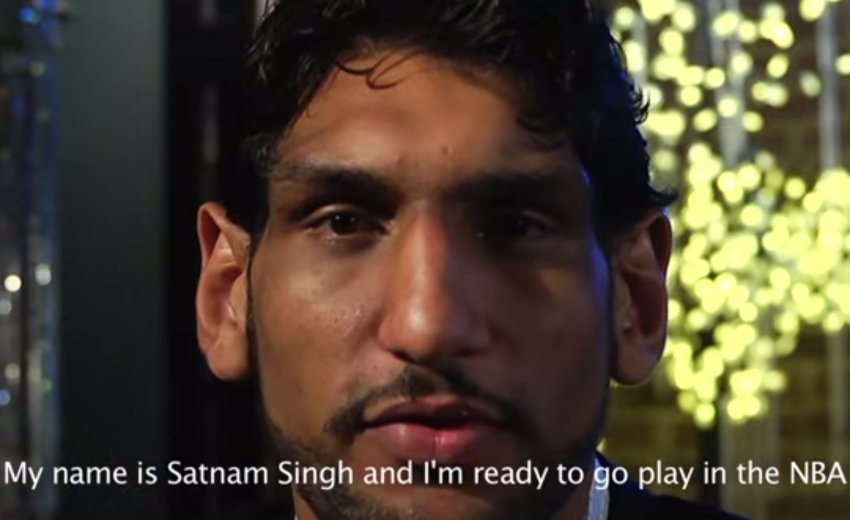The dirt road behind my father’s boyhood home in Ratlam was narrow enough. The broken-down auto rickshaws on the left side tightened our field further, leaving barely enough room for the cricket pitch and close infield. My cousins and the young neighborhood boys were impressed by my 5-9 frame — and my experience playing baseball, that foreign spinoff sport — and wanted to see me strike.
I gripped the long, flat bat like Gary Sheffield. I swung through the first bowl like Mark McGwire. I connected on the second like Frank Thomas. My cousins and the neighborhood boys beamed. They had never seen an uppercut swing, never seen an 11-year-old strike like that. The leather-bound cork ball exploded off the paddle’s sweet spot. For that moment, I felt like the strongest boy in India.
About 13 years later, in late 2011 or early 2012, a friend emailed me a link. Satnam Singh, the kid’s name was. He’s 15 years old. He’s 7-1. He’s playing at IMG Academy in Florida. And — he’s Indian. He’s going to the NBA. The YouTube clip wasn't unusual, as clumsy giants with the deft touch fall right into high school basketball stereotyes. And in 1 minute, 20 seconds, anyone can look special. But this one felt different. Familiar.
Another video of Singh came out a year later, and another a year after that. I’d watch, get excited, move on. I never expected to see Singh called to the podium in Barclays Center as the Mavericks selected him 52nd overall in the 2015 NBA Draft. Singh will play his first NBA Summer League game Sunday, when the Mavericks take on the Pelicans in Las Vegas at 4 p.m. ET. The game won’t be televised, but it can be streamed online — and with that, we will get the first real look at India’s first NBA prospect.
Those YouTube clips with the 7-2 teen being defended by kids 6 inches shorter illuminated the imagination, but India, well, it’s not exactly a successful athletic country. Aside from a pair of Cricket World Cup championships, a bygone dominant streak in Olympic men’s field hockey and Abhinav Bindra becoming the first Indian to win an individual Olympic gold in 2008’s 10 meter air rifle event, my father’s homeland has few sporting laurels on which to rest.
That’s what made Sim Bhullar special but … different. The 7-5 center became the first player of Indian descent to play in the NBA last season, when the Kings and Indian owner Vivek Ranadive gave him a single 10-day contract. But Bhullar, who won us over with his charisma and understanding of his role, grew up in Canada. He grew up playing the sport. He grew up playing real competition. He was 7-5 and played at New Mexico State for a successful coach in Marvin Menzies.
On the surface, they’re indistinguishable. Bhullar and Singh are giant men with slow feet and soft touches and unrefined footwork. Conditioning is an issue for both, but their vast potential shows. Neither quite fits into the modern aesthetic, the pace-and-space game, yet. But Singh has real potential as a shooter, and the Mavericks’ Texas Legends NBA Development League affiliate assuredly will test his range.
It’s also unclear whether either has a future in the NBA. The criticism has been clear: These men were drafted with hopes not of finding the next Yao Ming, NBA All-Star, but of finding the next Yao Ming, NBA ambassador to a nation of 1 billion. That’s troubling, and dismissing the possibility would be naive. The bankable good will generated among a large subset of fans almost certainly is viable enough for an NBA franchise to risk a 10-day contract or second-round draft pick.
But it also shouldn’t override the story. Because Satnam Singh Bhamara was drafted. Because Singh already has earned the praise of Mavs president Donnie Nelson and coach Rick Carlisle. Because Singh grew up over these past four years, grew up from being the strongest boy in India to being the 19-year-old man ready to take a nation’s expectations on his broad shoulders.
It’s not helped by the lack of other prospects. Yao had Wang Zhizhi and Mengke Bateer before him and Yi Jianlian and Sun Yue soon after. While the Chinese Basketball Association grows in stature and quality with each year, India’s game is popular on the streets but lacking in the structural programs of more successful basketball countries. Singh was part of a small group of prospects taken in by IMG a few years back, but the success of that program will be defined by him. The success of Indian basketball, at this stage, will be as well. That’s the way basketball culture is, the reason we point to a list of busts when Kristaps Porzingis is drafted fourth overall by the Knicks or get excited about the next Stephen Curry when a small-college point guard starts to shine. That’s not to say Singh would burn down bridges if he fails. There are no bridges, after all, and he and Bhullar have gone a long way toward constructing the framework.
I didn’t know how to play cricket back then. I didn’t understand the rules. I tried my best to pick them up, as explained to me by my younger cousins whom I was meeting for the first time. But mostly I wanted to meet their expectations. They glowed at the way I waggled that bat around like a small stick. I pulled it out to left field. I sent the ball so far that we couldn’t find it. Lost somewhere in the mess of the broken-down auto rickshaws.
There wasn’t another ball.
